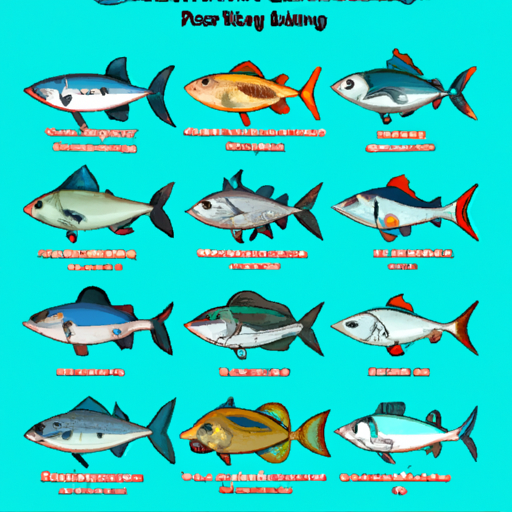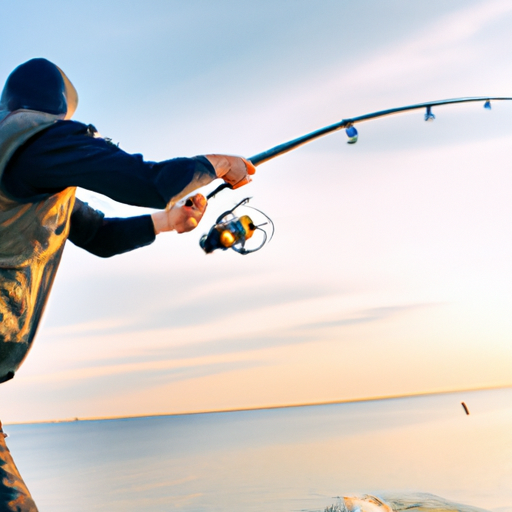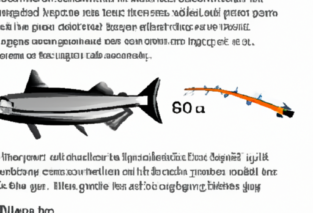Are you eager to cast your line into the water but unsure where to start? Look no further than “A Beginner’s Guide To Fishing In Different Seasons.” This comprehensive guide is designed specifically for those just beginning their fishing journey. Whether you’re a novice angler or someone looking to brush up on their skills, this guide will equip you with the knowledge and techniques needed to fish successfully in any season. From understanding the behavior of different fish species to mastering various fishing techniques, this guide will ensure that you’re well-prepared for your next fishing adventure. So grab your rod and get ready to embark on an exciting fishing journey in all seasons!

Preparing for Fishing
Fishing is an activity that can be enjoyed year-round, but each season brings its own unique challenges and opportunities. In order to make the most of your fishing trips, it is important to prepare properly. This guide will walk you through the key steps to prepare for fishing in different seasons, from choosing the right gear to understanding fish behavior and observing fishing regulations.
Choosing the Right Gear
Selecting the right gear is crucial to ensure a successful fishing trip. Depending on the season and the type of fish you are targeting, the gear requirements may vary. Choosing the right fishing rod, reel, and line that are suitable for the specific fishing conditions can greatly improve your chances of catching fish. Additionally, having a variety of hooks, sinkers, and floats in different sizes will allow you to adapt to different fishing situations.
Checking Fishing Regulations
Before heading out for a day of fishing, it is essential to familiarize yourself with the fishing regulations in your area. These regulations vary by location and help to protect the fish populations and preserve the ecosystem. You should be aware of any restrictions on fishing methods, size limits, bag limits, and closed seasons for certain fish species. By understanding and abiding by these regulations, you can contribute to the sustainability of the sport and ensure that future generations can enjoy fishing as well.
Getting the Necessary Permits
In addition to understanding the fishing regulations, you may need to obtain the necessary permits or licenses to fish legally. Many states and countries require anglers to have a fishing license, which can typically be obtained from the local fishing authority or online. It is important to have the appropriate permits with you while fishing to avoid any penalties or fines. Fishing without the proper permits not only goes against the law but also undermines the conservation efforts in place.
Understanding Fish Behavior in Different Seasons
Fish behavior is influenced by the changing seasons, and understanding these patterns can greatly improve your chances of success. In each season, fish may behave differently, such as spawning or seeking shelter in certain areas. By learning about the fish species in your area and their behavior during different seasons, you can better plan your fishing trips. Pay attention to factors such as water temperature, feeding patterns, and preferred habitats to determine where and when to fish.
Spring Fishing
Spring is an exciting time for fishing as the waters begin to warm up and fish become more active. Here are some key factors to consider when fishing in the spring.
Identifying Spring Fish Species
During the spring, many fish species become more active and start feeding in preparation for spawning. Some common spring fish species include bass, trout, walleye, and crappie. Research the local fish species in your area to understand their habits and behaviors during this season.
Locating Fish in Spring
As the water starts to warm up, fish begin to move to shallower areas in search of food. Look for areas with structure, such as submerged rocks, fallen trees, or weed beds, as these provide cover and attract baitfish. Additionally, pay attention to areas where the water temperature is slightly warmer than the surrounding areas, as fish tend to gravitate towards these areas during the spring.
Selecting the Right Bait and Lures for Spring Fishing
In the spring, fish are often more willing to chase and strike at lures as they become more active. Spinnerbaits, crankbaits, and soft plastics are all effective options for spring fishing. As for bait, live bait such as worms or minnows can be particularly successful during this time.
Tips for Spring Fishing Success
To increase your chances of success in spring fishing, consider the following tips:
- Start early: Fish are usually more active during the early morning hours, so try to get on the water as early as possible.
- Experiment with different lures and bait: Spring fishing can be unpredictable, so don’t be afraid to try different lures and bait until you find what the fish are biting.
- Pay attention to water temperature: Fish tend to be more active when the water temperature is warmer, so focus your efforts in areas with slightly higher temperatures.
- Don’t forget about safety: Spring weather can be unpredictable, so make sure to check the weather forecast and dress accordingly. Always wear a life jacket to ensure your safety on the water.
Summer Fishing
Summer is a popular season for fishing, with warm water and longer days providing ample opportunities to catch fish. Here’s what you need to know for successful summer fishing.
Targeting Warm-Water Species in Summer
In the summer, many warm-water species become more active and are easier to catch. Species such as bass, catfish, and panfish are commonly targeted during this season. These fish are more likely to be found in shallower waters near structures such as docks, weed beds, or submerged logs.
Finding Fish in Hot Weather
As the water temperature rises during the summer months, fish tend to seek cooler and deeper areas to escape the heat. Look for areas with shade, such as overhanging trees or structures like sunken boats, as these can provide relief from the sun and attract fish. Alternatively, try fishing in the early morning or late evening when the temperatures are cooler and fish are more active.
Optimal Bait and Lure Selection for Summer Fishing
During the summer, fish are more active and willing to chase after lures. Topwater baits such as poppers or buzzbaits can be effective in the early morning or late evening when fish are feeding near the surface. Soft plastics, jigs, and crankbaits are also popular choices for summer fishing. When it comes to bait, live bait such as nightcrawlers, minnows, or crickets can attract fish in warmer water temperatures.
Tips for Summer Fishing Success
To make the most of your summer fishing adventures, consider the following tips:
- Fish early or late in the day: Fish are generally more active during cooler parts of the day. Take advantage of the early morning or late evening when water temperatures are lower and fish are more likely to be feeding.
- Stay hydrated: The summer heat can be intense, so make sure to stay hydrated by drinking plenty of water and protecting yourself from the sun.
- Be patient: In hot weather, fish may be less active and more selective about their food. Stay persistent and try different techniques and baits until you find what works.
- Practice catch and release: During the warmer months, fish may be more stressed due to higher water temperatures. Consider practicing catch and release to minimize their harm and help preserve fish populations.
Fall Fishing
As the days grow shorter and the leaves start to change, fall presents a unique opportunity for anglers. Here’s what you need to know for successful fall fishing.
Recognizing Popular Fall Fish Species
Fall brings about changes in fish behavior as they prepare for the colder months ahead. Popular fall fish species include trout, salmon, pike, muskie, and bass. These fish often feed heavily during the fall as they build up energy for the upcoming winter.
Locating Fish during Autumn
In the fall, fish can be found in transition areas as they migrate from their summer habitats to their wintering grounds. Look for areas such as drop-offs, deep holes, and creek mouths as these serve as natural corridors for fish movement. Additionally, pay attention to changes in water temperature and target areas with slightly cooler water.
Choosing the Right Baits and Lures in Fall
During the fall, fish are more likely to feed on larger prey, preparing for the lean winter months. As such, larger baits and lures can be effective in attracting fish. Crankbaits, spinnerbaits, and jerkbaits mimic larger prey and can elicit strikes from fall fish. Additionally, using natural bait such as minnows or worms can be successful in colder water temperatures.
Tips for Fall Fishing Success
To maximize your success during fall fishing, keep these tips in mind:
- Use colors that mimic fall foliage: Fish may be more likely to strike at lures or bait that resemble the colors of falling leaves. Opt for baits in shades of orange, brown, or yellow to increase your chances of attracting fish.
- Fish during transitional periods: Pay attention to the weather and target periods of stability or slight drops in water temperature. These transitional periods often trigger increased fish activity and feeding.
- Be prepared for changing weather conditions: Fall weather can be unpredictable, with sudden changes in temperature and weather patterns. Dress in layers and bring appropriate rain gear to ensure your comfort while fishing.
- Respect spawning areas and restrictions: Many fish species spawn during the fall, so it is important to be mindful of their spawning grounds and adhere to any fishing restrictions or closures in place.

Winter Fishing
For those willing to brave the cold, winter fishing can offer a unique and rewarding experience. Here’s what you need to know for successful winter fishing.
Understanding Winter Fish Species and Behavior
In colder water temperatures, fish tend to slow down and become less active. However, certain species such as trout, walleye, crappie, and perch can still be targeted during the winter months. Understanding the behavior and movement patterns of these fish during winter can greatly improve your chances of success.
Locating Fish in Cold-Water Environments
During the winter, fish seek out areas with more stable water temperatures and ample food sources. Look for areas with deep water, such as drop-offs, channels, or the mouths of creeks. These areas tend to hold fish as they offer protection from the elements and a steady supply of food.
Selecting the Best Baits and Lures for Winter Fishing
In colder water, fish are less likely to chase after fast-moving lures. Slow and subtle presentations are often more effective when winter fishing. Jigging with small spoons or using live bait such as minnows or waxworms are popular choices. Additionally, brightly colored baits or lures can attract fish in low-light winter conditions.
Tips for Winter Fishing Success
To make the most of your winter fishing adventures, consider these tips:
- Dress in layers: Staying warm and comfortable is essential during winter fishing. Layering your clothing allows you to adjust your attire as needed to maintain a comfortable body temperature.
- Be cautious on frozen bodies of water: Only fish on ice that is at least 4 inches thick, and beware of any weak spots or signs of cracking. Safety should always be your top priority.
- Fish during the warmest parts of the day: Fish are generally more active during the warmest parts of the day, so plan your fishing trips accordingly.
- Be patient and adapt: Winter fishing may require more patience as fish activity decreases. Stay patient and be willing to experiment with different baits and techniques until you find what works.
Fishing Techniques
To become a well-rounded angler, it is important to learn and master a variety of fishing techniques. Here are some popular techniques to consider.
Casting Techniques
Casting is one of the fundamental skills in fishing. Practice different casting techniques such as overhead casting, sidearm casting, or roll casting to improve your accuracy and distance. Whether you are using a spinning reel, baitcasting reel, or fly reel, proper casting technique is essential for reaching your target.
Live Bait Fishing Techniques
Using live bait can be highly effective in attracting fish. Learn techniques such as bottom fishing, float fishing, or drift fishing to present live bait in a natural and enticing manner. Keep in mind the specific requirements of the fish species you are targeting and adjust your techniques accordingly.
Artificial Lure Fishing Techniques
Artificial lures come in a wide variety of shapes, sizes, and colors, and can be used to mimic natural prey. Techniques such as casting and retrieving, jerkbaiting, or trolling can all be employed with artificial lures. Experiment with different retrieves and speeds until you find a technique that entices strikes from fish.
Fly Fishing Techniques
Fly fishing is a unique and popular technique that involves casting an artificial fly made of natural or synthetic materials. Mastering techniques such as casting, mending, and stripping will allow you to present your fly in a convincing manner to fool fish. Fly fishing requires practice and patience, but the rewards are worth the effort.
Safety Considerations
Fishing is a safe and enjoyable activity, but it is important to prioritize safety to ensure a positive experience. Here are some safety considerations to keep in mind.
Importance of Wearing a Life Jacket
Wearing a life jacket or personal flotation device (PFD) is crucial, especially when fishing from a boat or in areas with strong currents. Accidents can happen unexpectedly, and a life jacket can provide valuable protection and increase your chances of survival in the water.
Being Aware of Weather Conditions
Weather conditions can change rapidly, and being aware of the forecast is essential for planning a safe fishing trip. Pay attention to factors such as wind speed, thunderstorms, or sudden temperature drops. If the weather deteriorates, consider rescheduling your fishing trip for another day.
Practicing Proper Equipment Handling
Proper handling of fishing equipment, such as rods, hooks, and knives, is essential for your safety and the safety of those around you. Always use caution when casting to avoid hooking yourself or others. When handling sharp objects, such as hooks or fillet knives, exercise caution and ensure you have a secure grip.
Understanding Basic First Aid for Fishing Emergencies
Having a basic understanding of first aid can be invaluable in case of a fishing emergency. Learn basic skills such as how to stop bleeding, perform CPR if needed, and treat common fishing injuries such as hook wounds or cuts. Carrying a first aid kit with you while fishing is also strongly recommended.
Conservation and Ethical Fishing
As anglers, it is our responsibility to protect the fish populations and preserve the natural environment. Here are some practices and guidelines for conservation and ethical fishing.
Catch and Release Practices
Catch and release is a technique where fish are caught and carefully returned to the water unharmed. This practice helps maintain fish populations and ensures the sustainability of the sport. When practicing catch and release, handle the fish gently, avoid removing them from the water for long periods, and use barbless hooks to minimize harm.
Respecting Fishing Regulations and Limits
Fishing regulations and limits are put in place to protect fish populations and their habitats. It is important to know and follow these regulations to ensure the long-term sustainability of fishing. Observe size limits, bag limits, and closed seasons for certain fish species in your area.
Cleaning Up after Your Fishing Trip
Leaving the fishing area as clean (or cleaner) than you found it is essential for preserving the environment and preventing pollution. Dispose of any garbage or fishing line properly and consider participating in local cleanup events to help maintain the beauty of our waterways.
Being Mindful of the Environment
While fishing, be mindful of the impact you have on the environment and take steps to minimize it. Avoid disturbing aquatic vegetation or sensitive habitats, and use environmentally friendly products whenever possible. By being conscious of our actions, we can help protect the fragile ecosystems that fish rely on.
Different Types of Fishing
There are various types of fishing that cater to different preferences and environments. Here are some popular types of fishing to explore.
Freshwater Fishing
Freshwater fishing takes place in lakes, rivers, ponds, and streams that contain freshwater fish species. From casting from the banks to fishing from a boat, freshwater fishing offers a wide range of opportunities to catch different species such as bass, trout, catfish, or pike.
Saltwater Fishing
Saltwater fishing is done in saltwater bodies such as oceans, bays, or estuaries and offers the chance to catch a diverse range of species such as tuna, snapper, marlin, or salmon. Whether you choose to fish from a pier, boat, or rock, saltwater fishing provides exhilarating challenges and exhilarating catches.
Ice Fishing
Ice fishing is a unique form of fishing done on frozen bodies of water. Anglers use specialized equipment such as ice augers and ice shelters to access the fish beneath the ice. Species like walleye, perch, pike, and trout can be targeted during the winter months through a hole cut in the ice.
Bank Fishing
Bank fishing simply refers to fishing from the shore, whether it be a riverbank, lake, or ocean shoreline. It is a versatile and accessible form of fishing that requires minimal equipment and allows anglers to explore different fishing spots without the need for a boat.
Kayak Fishing
Kayak fishing has gained popularity in recent years as a way to access remote fishing spots and enjoy a peaceful fishing experience. Fishing from a kayak allows anglers to silently navigate shallow waters and reach areas inaccessible to larger boats. It provides an opportunity to catch a variety of fish species while immersing yourself in nature.
Conclusion
Fishing is a rewarding and versatile activity that can be enjoyed throughout the year. By understanding the specific considerations for each season, selecting the right gear, and practicing responsible fishing techniques, you can increase your chances of success and have a memorable fishing experience. Whether you are a beginner or an experienced angler, always remember to prioritize safety, respect fishing regulations, and take steps to conserve our natural resources. So grab your gear and get ready for an exciting fishing adventure in any season!





